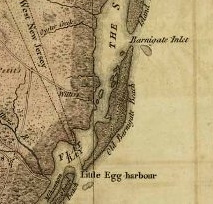This post begins a series that will reproduce select writings from the past that feature history, stories and tales of Long Beach Island. We begin with a few pages from Under Barnegat’s Beam.
THE GATEWAY TO LONG BEACH
We begin our story with a New Jersey town of many names. Were you to consult Scott’s Atlas, published in 1799, you would find it designated “Clamtown.” On a modern map it would be Tuckerton. These are only two of the numerous names by which it has been known through more than two and one-half centuries and each name is interwoven in its history.
 Thomas F. Gordon, in his “History of New Jersey,” published in 1834, refers to Tuckerton in this manner: “post town and port of entry for Little Egg Harbour district, about 35 miles S.E. of Mount Holly, 65 from Trenton, and 189 N.E. from W.C. (Washington, D.C.), situate on a narrow tongue of land, projecting into the marsh of Little Egg Harbour Bay, Little Egg Harbour town-ship, Burlington Co., contains between 30 and 40 dwellings, 4 taverns, 5 stores, 2 Methodist churches, a Quaker meeting house. It lies upon a navigable stream, called Shord’s Mill Branch, 6 miles from the Bay, whence wood scows and flats ascend to the town. There is a large business done here in timber and cord-wood; and salt is, or was manufactured in the vicinity. The town is frequented during the summer by many persons for the benefit of sea-bathing, &c. A stage plies regularly between it and Philadelphia.”
Thomas F. Gordon, in his “History of New Jersey,” published in 1834, refers to Tuckerton in this manner: “post town and port of entry for Little Egg Harbour district, about 35 miles S.E. of Mount Holly, 65 from Trenton, and 189 N.E. from W.C. (Washington, D.C.), situate on a narrow tongue of land, projecting into the marsh of Little Egg Harbour Bay, Little Egg Harbour town-ship, Burlington Co., contains between 30 and 40 dwellings, 4 taverns, 5 stores, 2 Methodist churches, a Quaker meeting house. It lies upon a navigable stream, called Shord’s Mill Branch, 6 miles from the Bay, whence wood scows and flats ascend to the town. There is a large business done here in timber and cord-wood; and salt is, or was manufactured in the vicinity. The town is frequented during the summer by many persons for the benefit of sea-bathing, &c. A stage plies regularly between it and Philadelphia.”
Tuckerton was more than a hundred and twenty-five years old when Gordon described it since it had been settled by the Friends in the 1690’s and a Quaker Meeting had been established by 1702. The locality took its name from this meeting house-“Little Egg Harbour.” Later it was known as “Middle of the Shore,” both of these being regional rather than place names. The town itself was referred to as “Quakertown.” A few old maps show the village as “Fishtown.”
The present name, Tuckerton, was decided upon at a township feast in 1798. Ebenezer Tucker, a remarkable man, invited the entire community to a great dinner of boiled beef and pork, boiled turnips and potatoes, beans and rye bread. The dinner was given by this entrepreneur for the express purpose of having the thriving town named for himself.
Clamtown Becomes Tuckerton
After 1800 the name appears on maps as Tuckertown, Tuckinton and Tuckerton, evidently depending upon the whim of the map maker. The enterprise and ingenuity of Ebenezer Tucker seemed to inspire the town people and long survived him.
An increasing number of persons frequented the town during the summer season for the benefit of sea-bathing. Long Beach, the island across the Bay, attracted more and more summer visitors. The stage spoken of by Gordon gave way to the railroad. Many of these visitors came to Tuckerton by rail and were ferried across the Bay in boats. Tuckerton became the gateway to Long Beach.
This traffic steadily increased. ln 1872 the railroad built a short spur from its mainline at Tuckerton to a spot on the mainland bay shore called Edge Cove. This was before the railroad bridge was built across Manahawkin Bay connecting Long Beach with the mainland. Railroad transportation for passengers, baggage and freight bound for Long Beach then ended at Edge Cove. The steamboats ‘Barclay” and “Pohatcong” carried passengers and freight across to Beach Haven. After arrival at Beach Haven passengers for boarding houses at other locations on the island were sailed up the Bay to their destinations. All in all, it made the trip a full day’s journey.
When direct rail service to Long Beach was established in June, 1886, the year in which the railroad bridge across the Bay was completed, the Edge Cove spur was abandoned. However, only the switch connecting the spur to the mainline was removed. The rails remained across the meadow as did one flat car.